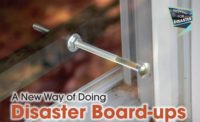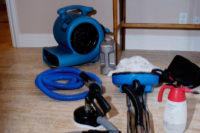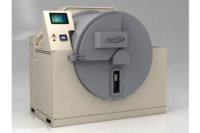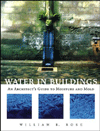Despite the frequency of mold being identified as a contaminant in attics and crawlspaces, there is surprisingly little in the way of controlled research to help building owners and contractors determine the most effective and cost-efficient means of addressing such problems. John DiMenno of G.S. Jones and Sons in Pittsburgh has offered a 45-page treatise discussing the causes and corrective actions necessary to deal with mold in attics as part of his post-class efforts at earning a Certified Mold Professional (CMP) designation from the Restoration Industry Association. In that paper, he identified the four most common scenarios that lead to an awareness of fungal contamination in an attic as:
- Remodeling or other construction activities, such as electrical work that requires new wiring to be passed through the attic.
- Removal or storage of items in the attic, such as holiday displays.
- Response to a roof leak that has reached the occupied areas of the home.
- Sale or purchase of the house.
The last situation is especially stressful for homeowners, since addressing mold problems is a compounding factor to the financial and scheduling pressures that often accompany building transactions. Currently, sanding, media blasting, dry ice blasting and hydrogen peroxide sprays are used to treat mold in tight spaces like attics and crawlspaces. But is there a better way?
Shortcomings of Traditional Techniques
Although the aforementioned remediation techniques work, they each have their drawbacks. Sanding or wire brushing, whether by hand or with powered equipment, is very labor intensive. Such mold removal efforts also leave the surfaces abraded and pose real difficulties in reaching the seemingly endless nooks and crannies that are inherently part of attics and crawlspaces. Media blasting, whether baking soda, sponges or exotic materials like pecan shells are used, introduces the volume and weight of the blast media that has to be cleaned up. Although dry ice blasting eliminates the problem of having to clean up spent blast media (the dry ice sublimates directly to a gas so there is no physical residue), such cleaning introduces large volumes of carbon dioxide into the small spaces, which creates a suffocation risk. Hydrogen peroxide sprays help with the labor/efficiency and clean-up issues, but present their own safety peril from the danger that such chemicals pose to eyes and skin.
Another concern is that although these techniques can be effective in removing mold, they offer varying degrees of success in addressing the residual enzyme staining that often accompanies fungal growth on wooden studs and sheathing. All too often, particularly in the case of home sales, judgments are made regarding risk from fungal contamination based solely on a visual impression. Therefore, visual improvement in attics and crawlspaces following remediation is critical in avoiding a red flag from a home inspector during a property transaction, and provides assurance to the homeowner that the problem has been resolved.
A New Approach to Dealing with Mold in Confined Spaces
In an effort to address these difficulties, there’s now a unique mold stain remover product available in the industry. Several years of laboratory and field testing support the contention that the product by Concrobium Professional Restoration Products, which is mixed on-site to create a short-lived peracetic acid, is an efficient and effective way to clean mold-contaminated spaces. Given this data, this mold stain remover and a second mold control product can be integrated into a specific remediation process that not only removes biological growth and attendant staining, but leaves a safe residue to protect the surfaces from future mold growth.
To build on the bench research and anecdotal data, this “Attic Attack” process was tested in an actual mold remediation project, contracting with Wonder Makers Environmental to lead a case study that evaluated whether it noticeably improves the appearance of wood by removing mold stains as it helps remove contamination.
The Study
The home that was used for the test was located in Ohio. There were three separate attics in the home (east, middle, and west). In general, the soffit vents serving the attic spaces were ineffective at allowing air in as they had been painted over through the years. Additionally, a bathroom exhaust from the second floor was ventilated into the east attic space. During a recent real estate home inspection, visible mold was observed on the structural wood framing and plywood roof deck in the east and middle attics. To address the problem, the homeowners contacted a local remediation contractor, which was one of the firms that was looking for an appropriate test site where this Attic Attack methodology could be implemented.
Sampling, using four separate methods, recorded the effectiveness before, during and after the work was conducted. Both surface and air sampling were conducted in the attics. Air samples were also collected in the occupied area of the home, and outdoor air samples were taken to confirm ambient conditions. Surfaces were tested with both adenosine triphosphate (ATP) technology, which measures biological residue, and the collection of actual surface materials. Direct samples of the surfaces were collected from the wooden studs and roof decking using a “microvacuum” technique and also Bio-Tape sample collection devices. There, direct samples were subjected to visual microscopy, as were the air samples.
In Conclusion
The extensive review of this real-life project and collection of over 75 samples provided enough evidence to draw some important conclusions about the process and effectiveness of the procedure. Although it sounds simple, one of the most important conclusions was that the home selected for the case study was an excellent example of a residence with mold-contaminated attics. Though the overall house appeared to be well-maintained, the attics had some long-standing ventilation and bathroom exhaust issues, along with evidence of past roof leaks, which have caused the documented mold conditions.
Of course, the big question is, did the procedure work well? It produced very favorable results in a number of critical areas that are commonly identified as problems associated with mold remediation in attics. Most important, all the attics showed a marked and consistent reduction in surface fungal concentrations. All the surface sampling methods (ATP, microvacuum and Bio-Tape) showed significant reductions from the pre-work samples to the post-fogging evaluation. The ATP results were tabularized as noted in the above table.
Another critical outcome was that visible staining was removed, leaving the substrates with a clean look. The Attic Attack remediation process was also straightforward and simple to implement.












Report Abusive Comment